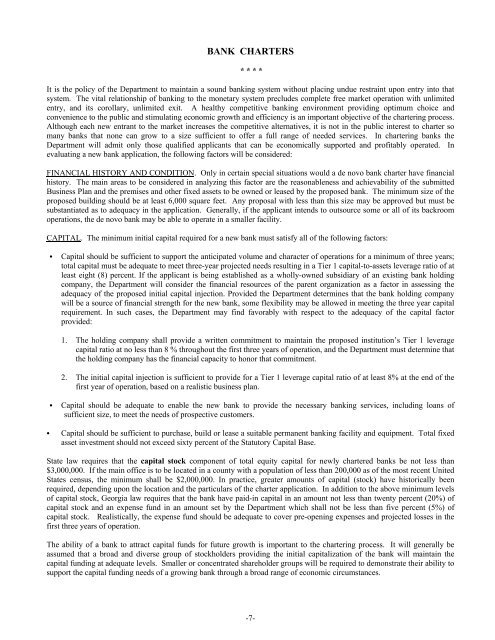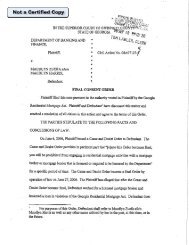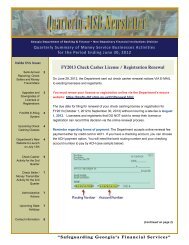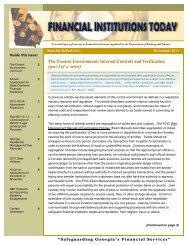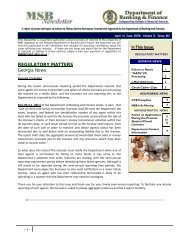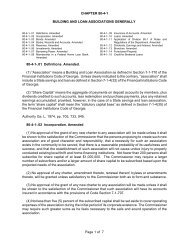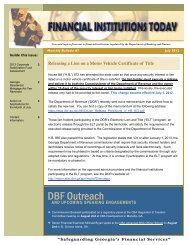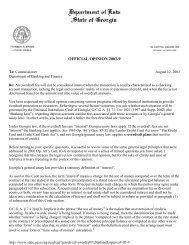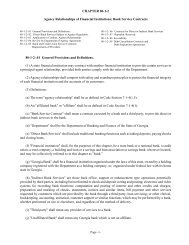facts about chartering a state-chartered bank - Department of ...
facts about chartering a state-chartered bank - Department of ...
facts about chartering a state-chartered bank - Department of ...
You also want an ePaper? Increase the reach of your titles
YUMPU automatically turns print PDFs into web optimized ePapers that Google loves.
BANK CHARTERS<br />
* * * *<br />
It is the policy <strong>of</strong> the <strong>Department</strong> to maintain a sound <strong>bank</strong>ing system without placing undue restraint upon entry into that<br />
system. The vital relationship <strong>of</strong> <strong>bank</strong>ing to the monetary system precludes complete free market operation with unlimited<br />
entry, and its corollary, unlimited exit. A healthy competitive <strong>bank</strong>ing environment providing optimum choice and<br />
convenience to the public and stimulating economic growth and efficiency is an important objective <strong>of</strong> the <strong>chartering</strong> process.<br />
Although each new entrant to the market increases the competitive alternatives, it is not in the public interest to charter so<br />
many <strong>bank</strong>s that none can grow to a size sufficient to <strong>of</strong>fer a full range <strong>of</strong> needed services. In <strong>chartering</strong> <strong>bank</strong>s the<br />
<strong>Department</strong> will admit only those qualified applicants that can be economically supported and pr<strong>of</strong>itably operated. In<br />
evaluating a new <strong>bank</strong> application, the following factors will be considered:<br />
FINANCIAL HISTORY AND CONDITION. Only in certain special situations would a de novo <strong>bank</strong> charter have financial<br />
history. The main areas to be considered in analyzing this factor are the reasonableness and achievability <strong>of</strong> the submitted<br />
Business Plan and the premises and other fixed assets to be owned or leased by the proposed <strong>bank</strong>. The minimum size <strong>of</strong> the<br />
proposed building should be at least 6,000 square feet. Any proposal with less than this size may be approved but must be<br />
substantiated as to adequacy in the application. Generally, if the applicant intends to outsource some or all <strong>of</strong> its backroom<br />
operations, the de novo <strong>bank</strong> may be able to operate in a smaller facility.<br />
CAPITAL. The minimum initial capital required for a new <strong>bank</strong> must satisfy all <strong>of</strong> the following factors:<br />
C Capital should be sufficient to support the anticipated volume and character <strong>of</strong> operations for a minimum <strong>of</strong> three years;<br />
total capital must be adequate to meet three-year projected needs resulting in a Tier 1 capital-to-assets leverage ratio <strong>of</strong> at<br />
least eight (8) percent. If the applicant is being established as a wholly-owned subsidiary <strong>of</strong> an existing <strong>bank</strong> holding<br />
company, the <strong>Department</strong> will consider the financial resources <strong>of</strong> the parent organization as a factor in assessing the<br />
adequacy <strong>of</strong> the proposed initial capital injection. Provided the <strong>Department</strong> determines that the <strong>bank</strong> holding company<br />
will be a source <strong>of</strong> financial strength for the new <strong>bank</strong>, some flexibility may be allowed in meeting the three year capital<br />
requirement. In such cases, the <strong>Department</strong> may find favorably with respect to the adequacy <strong>of</strong> the capital factor<br />
provided:<br />
1. The holding company shall provide a written commitment to maintain the proposed institution’s Tier 1 leverage<br />
capital ratio at no less than 8 % throughout the first three years <strong>of</strong> operation, and the <strong>Department</strong> must determine that<br />
the holding company has the financial capacity to honor that commitment.<br />
2. The initial capital injection is sufficient to provide for a Tier 1 leverage capital ratio <strong>of</strong> at least 8% at the end <strong>of</strong> the<br />
first year <strong>of</strong> operation, based on a realistic business plan.<br />
C Capital should be adequate to enable the new <strong>bank</strong> to provide the necessary <strong>bank</strong>ing services, including loans <strong>of</strong><br />
sufficient size, to meet the needs <strong>of</strong> prospective customers.<br />
C Capital should be sufficient to purchase, build or lease a suitable permanent <strong>bank</strong>ing facility and equipment. Total fixed<br />
asset investment should not exceed sixty percent <strong>of</strong> the Statutory Capital Base.<br />
State law requires that the capital stock component <strong>of</strong> total equity capital for newly <strong>chartered</strong> <strong>bank</strong>s be not less than<br />
$3,000,000. If the main <strong>of</strong>fice is to be located in a county with a population <strong>of</strong> less than 200,000 as <strong>of</strong> the most recent United<br />
States census, the minimum shall be $2,000,000. In practice, greater amounts <strong>of</strong> capital (stock) have historically been<br />
required, depending upon the location and the particulars <strong>of</strong> the charter application. In addition to the above minimum levels<br />
<strong>of</strong> capital stock, Georgia law requires that the <strong>bank</strong> have paid-in capital in an amount not less than twenty percent (20%) <strong>of</strong><br />
capital stock and an expense fund in an amount set by the <strong>Department</strong> which shall not be less than five percent (5%) <strong>of</strong><br />
capital stock. Realistically, the expense fund should be adequate to cover pre-opening expenses and projected losses in the<br />
first three years <strong>of</strong> operation.<br />
The ability <strong>of</strong> a <strong>bank</strong> to attract capital funds for future growth is important to the <strong>chartering</strong> process. It will generally be<br />
assumed that a broad and diverse group <strong>of</strong> stockholders providing the initial capitalization <strong>of</strong> the <strong>bank</strong> will maintain the<br />
capital funding at adequate levels. Smaller or concentrated shareholder groups will be required to demonstrate their ability to<br />
support the capital funding needs <strong>of</strong> a growing <strong>bank</strong> through a broad range <strong>of</strong> economic circumstances.<br />
-7-


